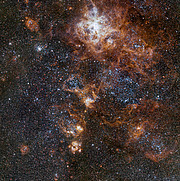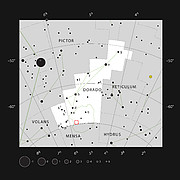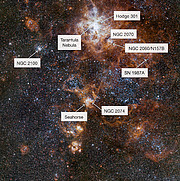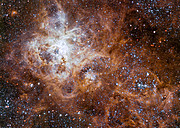Comunicato Stampa
Un quartiere affollato
30 Maggio 2018
Brillando da circa 160 000 anni luce di distanza, la Nebulosa Tarantola è la struttura più spettacolare della Grande Nube di Magellano, una galassia satellite della nostra Via Lattea. Il telescopio VST (VLT Survey Telescope) all'Osservatorio del Paranal dell'ESO, in Cile, ha ritratto questa regione e i suoi dintorni spettacolari con dettagli squisiti. Si rivela un paesaggio cosmico di ammassi stellari, di nubi di gas caldo rilucenti e di resti sparsi di esplosioni di supernova. È l'immagine più nitida mai ottenuta di questa zona del cielo.
Sfruttando le capacità del telescopio VST (VLT Survey Telescope) all'Osservatorio del Paranal dell'ESO in Cile, alcuni astronomi hanno catturato questa immagine dettagliatissima della Nebulosa Tarantola e dei suoi numerosi vicini: nebulose e ammassi stellari. La Tarantola, nota anche come 30 Doradus, è la regione di formazione stellare più brillante e la più energetica nel Gruppo Locale di galassie.
La Nebulosa Tarantola, in alto nell'immagine, si trova nella costellazione del Dorado nel cielo meridionale e si estende per più di 1000 anni luce. Questa stupenda nebulosa appartiene alla Grande Nube di Magellano, una galassia nana grande circa 14 000 anni luce, una delle galassie più vicine alla Via Lattea.
Nel cuore della Nebulosa Tarantola si trova NGC 2070, un giovane ma gigantesco ammasso stellare, una regione di formazione stellare il cui nucleo denso, R136, contiene alcune delle stelle più massicce e luminose che si conoscano. Il brillante riverbero della Nebulosa Tarantola è stato registrato per la prima volta dall'astronomo francese Nicolas-Louis de Lacaille nel 1751.
Un altro ammasso stellare nella Nebulosa Tarantola è Hodge 301, molto più vecchio, in cui si stima che almeno 40 stelle siano già esplose come supernove, spargendo il loro gas in tutta la regione. Un esempio di resto di supernova è la "superbolla" SNR N157B, che contiene l'ammasso stellare aperto NGC 2060. L'ammasso è stato osservato per la prima volta dall'astronomo inglese John Herschel nel 1836, con un telescopio riflettore da 18,6 pollici (47 cm) dal Capo di Buona Speranza, oggi in Sudafrica. Al bordo della Nebulosa Tarantola, in basso a destra, è possibile identificare la posizione della famosa supernova SN 1987A [1].
Spostandoci sul lato sinistro della Nebulosa Tarantola, vediamo un ammasso aperto luminoso, NGC 2100, che mostra una concentrazione di stelle blu e brillanti, circondata da stelle rosse. L'ammasso è stato scoperto dall'astronomo scozzese James Dunlop nel 1826 mentre lavorava in Australia con il telescopio riflettore da 9 pollici (23 cm) che si era costruito da solo.
Al centro dell'immagine si nota NGC 2074, un ammasso stellare con nebulosa a emissione, un'altra zona di formazione stellare massiccia scoperta da John Herschel. Osservandola da vicino si può individuare una struttura scura di polvere, a forma di cavalluccio marino - il "Cavalluccio marino della Grande Nube di Magellano". È una struttura gigantesca, a guisa di pilastro, lunga circa 20 anni luce - circa quattro volte la distanza tra il Sole e la stella più vicina, Alfa Centauri. La struttura è condannata a sparire nei prossimi milioni di anni: a mano a mano che si formano stelle nell'ammasso, la luce e i venti da loro emessi spazzeranno via gradualmente i pilastri di polvere.
La realizzazione di questa immagine è stata possibile solo grazie alla camera del VLT da 256 megapixel, OmegaCAM, progettata appositamente per il VST. L'immagine è creata a partire da immagini di OmegaCAM prese con quattro diversi filtri di colore, tra cui uno costruito per isolare la luce rossa dell'idrogeno ionizzato [2].
Note
[1] SN 1987A è stata la prima supernova osservata con telescopi moderni e la più brillante dopo la Stella di Keplero nel 1604. SN1987A era così intensa che per parecchi mesi dopo la sua scoperta il 23 febbraio 1987 avvampò con la potenza di 100 milioni di soli.
[2] La riga di emissione H-alfa è una riga spettrale rossa prodotta quando l'elettrone all'interno di un atomo di idrogeno perde la propria energia. Ciò accade nell'idrogeno intorno alla stelle giovani e calde poichè il gas viene ionizzato dall'intensa radiazione ultravioletta e gli elettroni quindi si ricombinano con i protoni per formare di nuovo atomi di idrogeno. L'abilità di OmegaCAM di rilevare questa riga permette agli astornomi di caratterizzare la fisica delle nubi molecolari giganti in cui si formano nuove stelle e pianeti.
Ulteriori Informazioni
L'ESO (European Southern Observatory, o Osservatorio Australe Europeo) è la principale organizzazione intergovernativa di Astronomia in Europa e di gran lunga l'osservatorio astronomico più produttivo al mondo. È sostenuto da 15 paesi: Austria, Belgio, Danimarca, Finlandia, Francia, Germania, Italia, Paesi Bassi, Polonia, Portogallo, Regno Unito, Repubblica Ceca, Spagna, Svezia, e Svizzera, oltre al paese che ospita l'ESO, il Cile e l'Australia come partner strategico. L'ESO svolge un ambizioso programma che si concentra sulla progettazione, costruzione e gestione di potenti strumenti astronomici da terra che consentano agli astronomi di realizzare importanti scoperte scientifiche. L'ESO ha anche un ruolo di punta nel promuovere e organizzare la cooperazione nella ricerca astronomica. L'ESO gestisce tre siti osservativi unici al mondo in Cile: La Silla, Paranal e Chajnantor. Sul Paranal, l'ESO gestisce il Very Large Telescope, osservatorio astronomico d'avanguardia nella banda visibile e due telescopi per survey. VISTA, il più grande telescopio per survey al mondo, lavora nella banda infrarossa mentre il VST (VLT Survey Telescope) è il più grande telescopio progettato appositamente per produrre survey del cielo in luce visibile. L'ESO è il partner principale di APEX e di ALMA, il più grande progetto astronomico esistente, sulla piana di Chajnantor. E sul Cerro Armazones, vicino al Paranal, l'ESO sta costruendo l'Extremely Large Telescope o ELT (significa Telescopio Estremamente Grande), un telescopio da 39 metri che diventerà "il più grande occhio del mondo rivolto al cielo".
La traduzione dall'inglese dei comunicati stampa dell'ESO è un servizio dalla Rete di Divulgazione Scientifica dell'ESO (ESON: ESO Science Outreach Network) composta da ricercatori e divulgatori scientifici da tutti gli Stati Membri dell'ESO e altri paesi. Il nodo italiano della rete ESON è gestito da Anna Wolter.
Contatti
Richard Hook
ESO Public Information Officer
Garching bei München, Germany
Tel.: +49 89 3200 6655
Cell.: +49 151 1537 3591
E-mail: rhook@eso.org
Sul Comunicato Stampa
| Comunicato Stampa N": | eso1816it-ch |
| Nome: | Tarantula Nebula |
| Tipo: | Local Universe : Star : Grouping : Cluster Local Universe : Nebula |
| Facility: | VLT Survey Telescope |
| Instruments: | OmegaCAM |






